Vice Versa (2007)
«Vice Versa» is comprised of two audio-visual installations in the big and small cisterns in Berlin Prenzlauer Berg. It was commissioned by the Singuhr Hœrgalerie and realised with the Studio for electroacoustic Music (SeaM) Weimar.
The project underlines the opposites of the two historical spaces: large / small, centrifugal / peripheric, hermetic / open … The installation in the large cistern was elaborated by Robert Rehnig, while Hanns Holger Rutz and Ludger Hennig have composed the work for the “small” cistern (its circular base still has a diameter of around thirty meters!). As a physical object, an exceptionally long steel string is installed vertically in the tower of the large cistern. In the small cistern, a multitude of quadratic steel plates that seem to float above the floor are installed. They are equilibrated by the same number of speakers that are suspended in a height of around four meters in the vault. The string, the plates and the speakers are connected to a computer system and electromechanically stimulated.
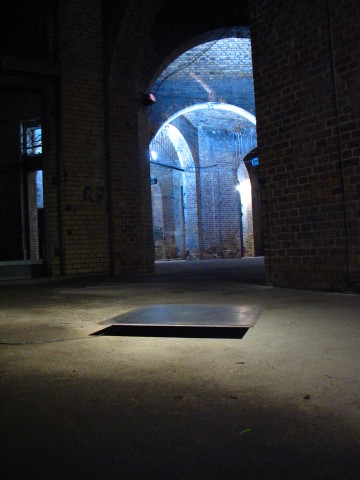
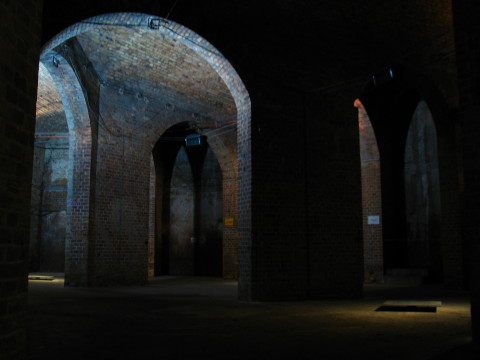
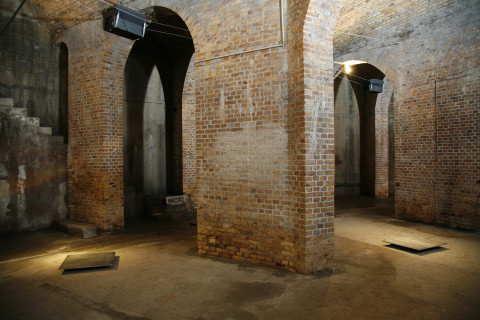
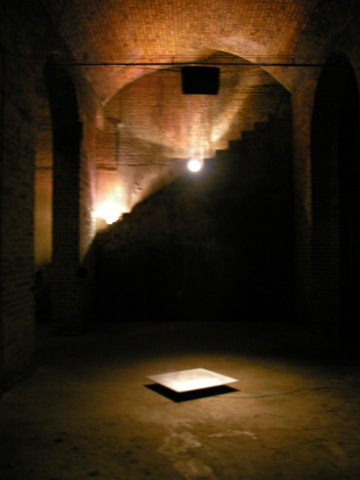
General concept
The small cistern feels much more open and breathing compared to the large cistern. The motion of the visitor is explorative with a focus on lateral flow, the center is transparent and carries the vista over to the opposite fringe. The openess and the freedom of choice are reflected by a fluctuating and roaming constellation of noise. Instead of conceiving the “Speicher” (tank) as a hermetic immutable box, it is seen in analogy to “Gedächtnis” (memory) as a rustling field which is in permanent flux, which is not constructed by its cladding, but by changing entanglements and dislocations, by environmental influences. The cistern is understood as a labyrinthic “Möglichkeitsraum” (space of possibilities) which is set into oscillation by the trajectories of the visitors as they move around. The field, the labyrinth, the wish, the possibility are all rooted in distance, absence. The installation, into which the movements of the visitors are inscribed, is playing with this horizon. At the same time, the steel plates create spots of attraction: The resonances of the plates emerge out of the monochromacity of the noise when the visitor approaches them.
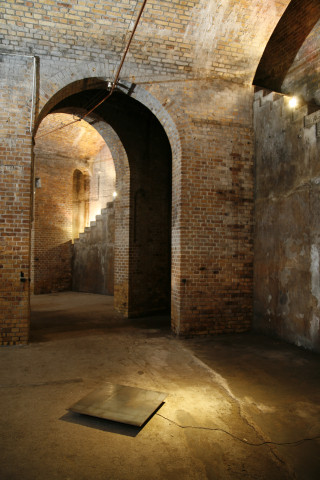
Compositional details
An algorithm tries to construct trajectories from light barrier sensors that are triggered by the visitors. The sectors of the space are categorized as “inside-area”, “neighbouring-area”, “distant-area”, “diametric-area”. At the same time, the sensors feed an invisible field of cellular automata, that is they create patterns that virtually travel across the space and have the aural effect of modulating the sound in a subtle way.
The sound materials both for speakers and transducers are derived from the spatial categories. A sizzling sharp impulsive noise was chosen for the “inside-area” since it is perspicuously reflected from the vault. Due to the acoustic lense character of the vault, the locating of this sound is shifting along with the visitor moving around. Darker articulated noise(s) with concrete origin are prevailing in the “neighbouring-areas”. The recurring sound of a remote railway train acts as a metaphorical motif. The distant areas are sounded with noise textures that are modulated in resonances (colour) and amplitude.
The interactivity layer is configured with probabilities which for example delay or constrain the mutations of the sound. The space sound is repeatedly filtered and thinned out. From time to time, a dark sound made from brownian noise is emerging and ebbing away.
The visitor is asked to sensitise their ears to the different possibilities of locating sound, to hear the sound in its depth differentiation and perspectivity. The light which is changing very slowly, is reflecting this adaptation process which corresponds to the optical adaptation when changing between a dark and a light room. The illumination of the architecture is in constant flux, the perspective and formation of shades are changing. The center of the cistern is left in darkness, it is the non-space which merely acts as an acoustic and visual window to the opposite side of the reservoir.
The steel plates contrast the rushing vault-sound by floating close to the ground and emitting resonant glissandi. As a horizontal structure they also appear as a counter-element to the vertical tower of the large cistern.
The light and sound composition was carried out in SuperCollider.
Vice Versa (room rec.; use headphones)